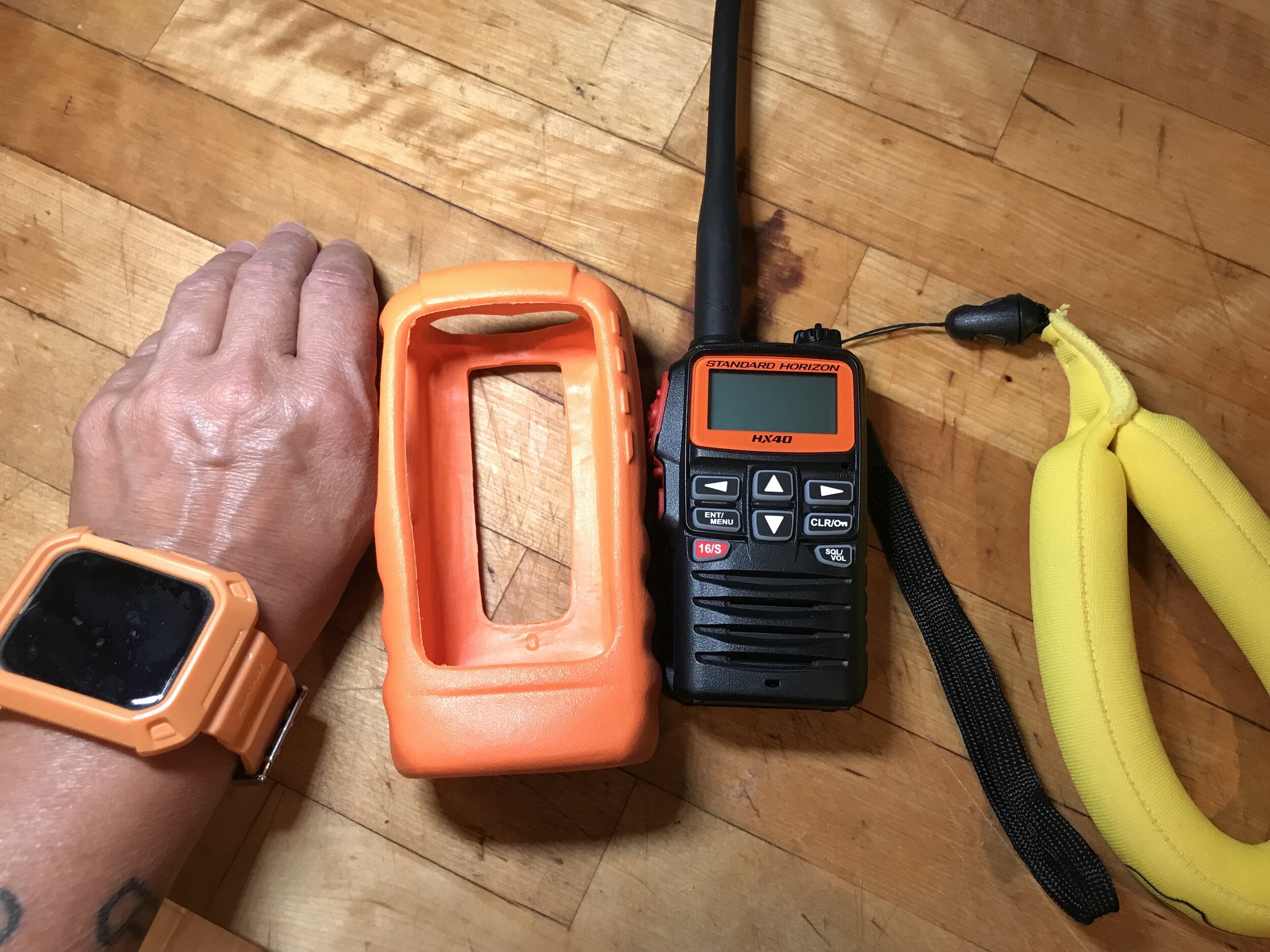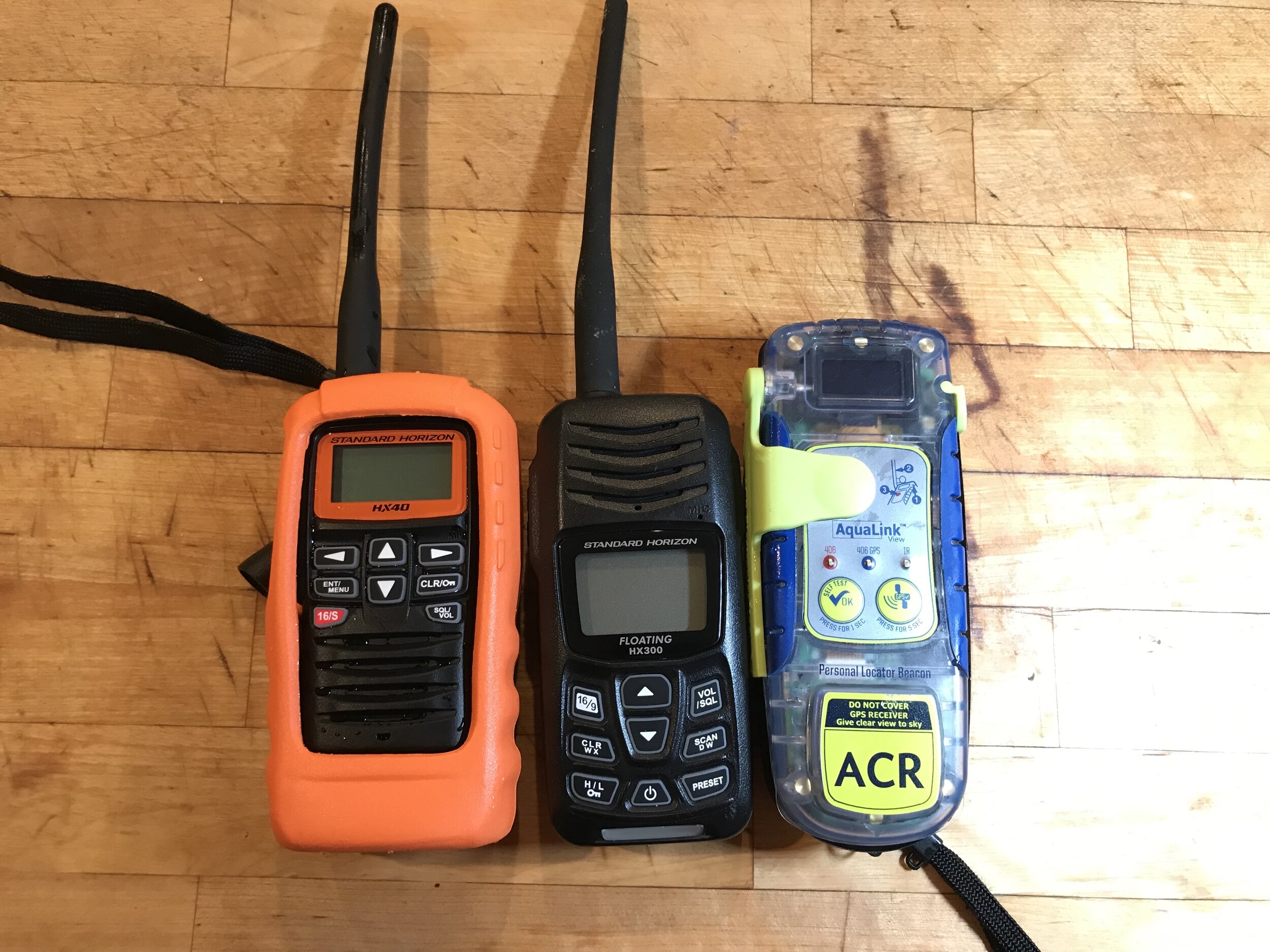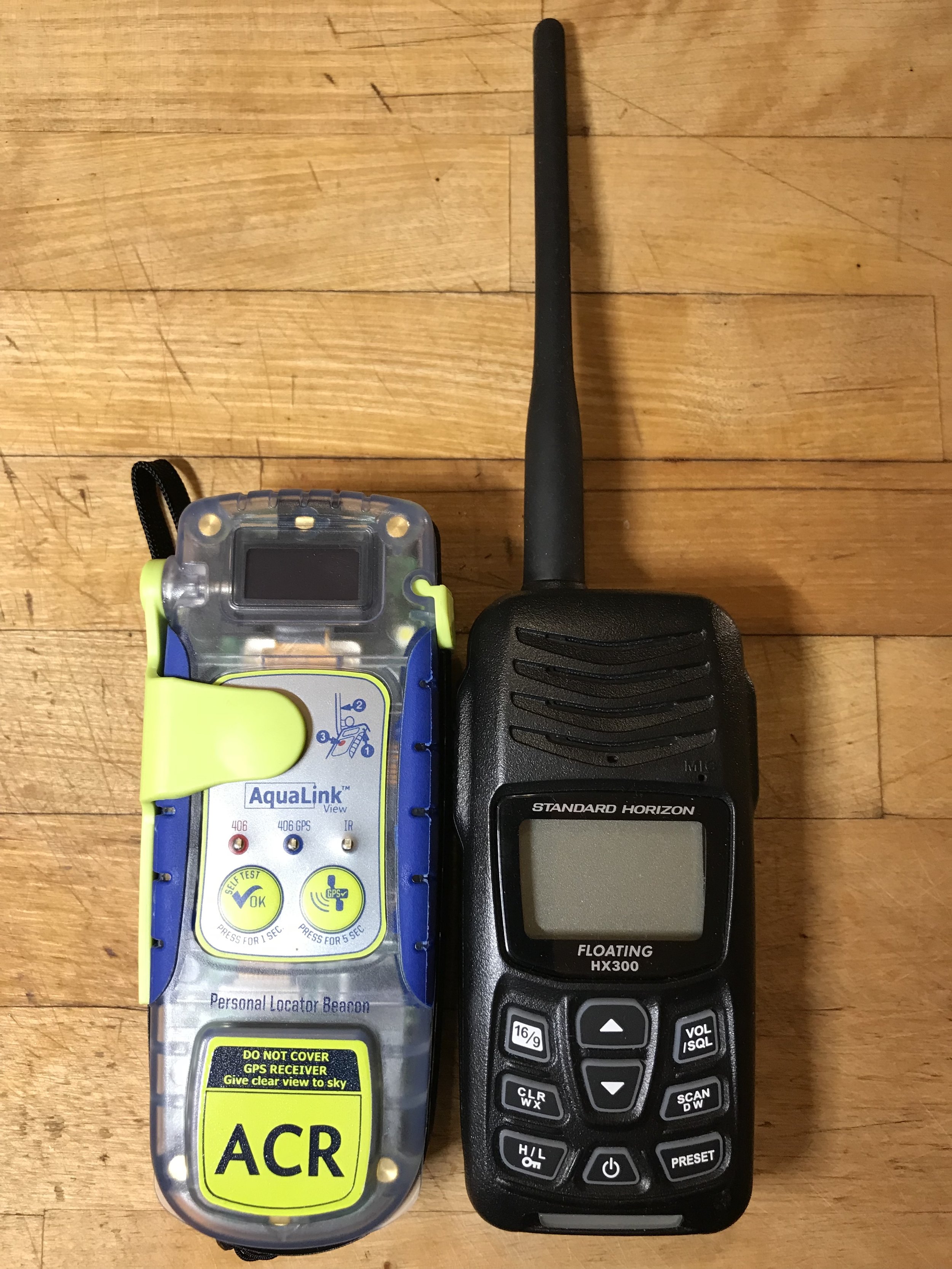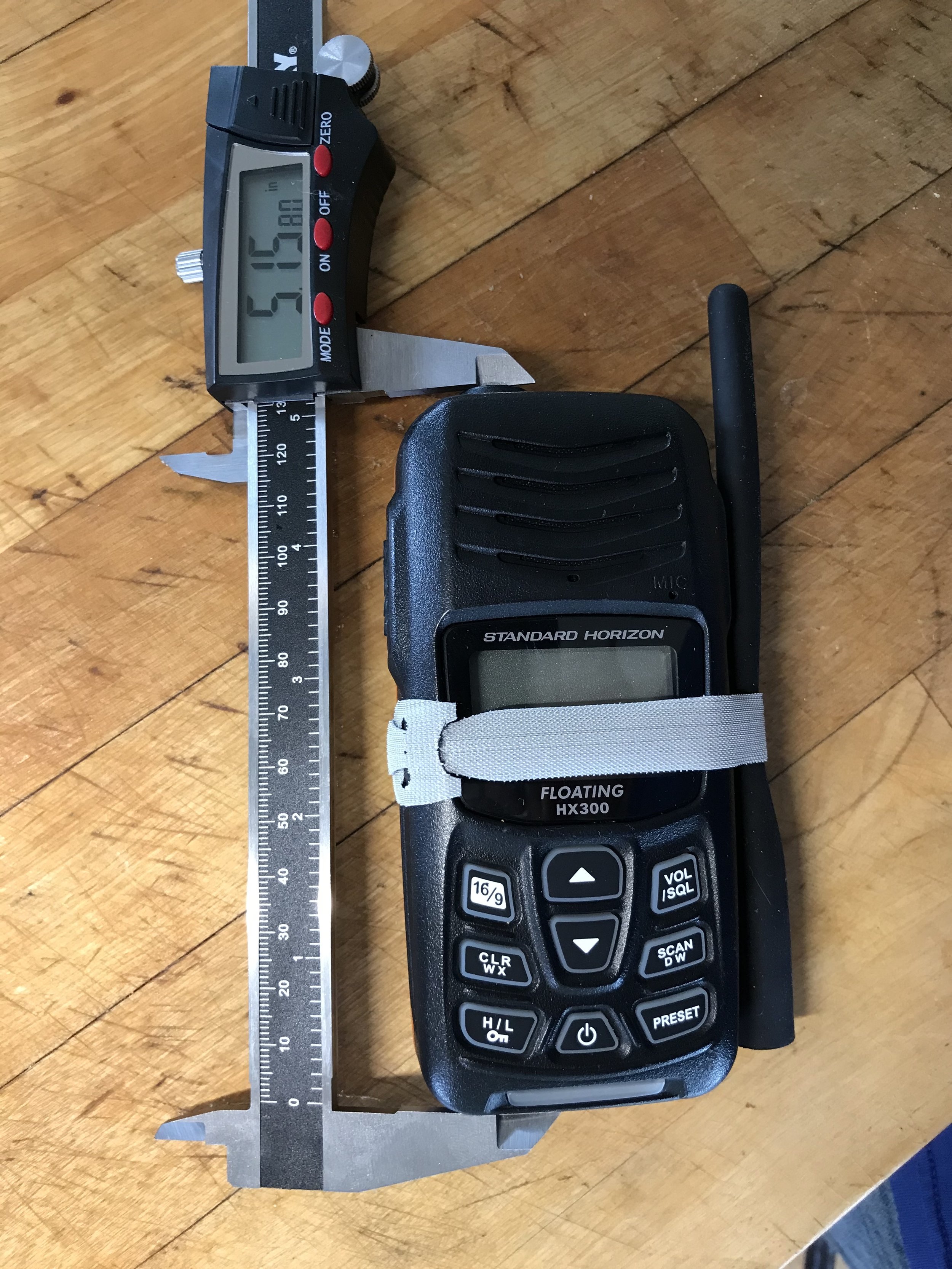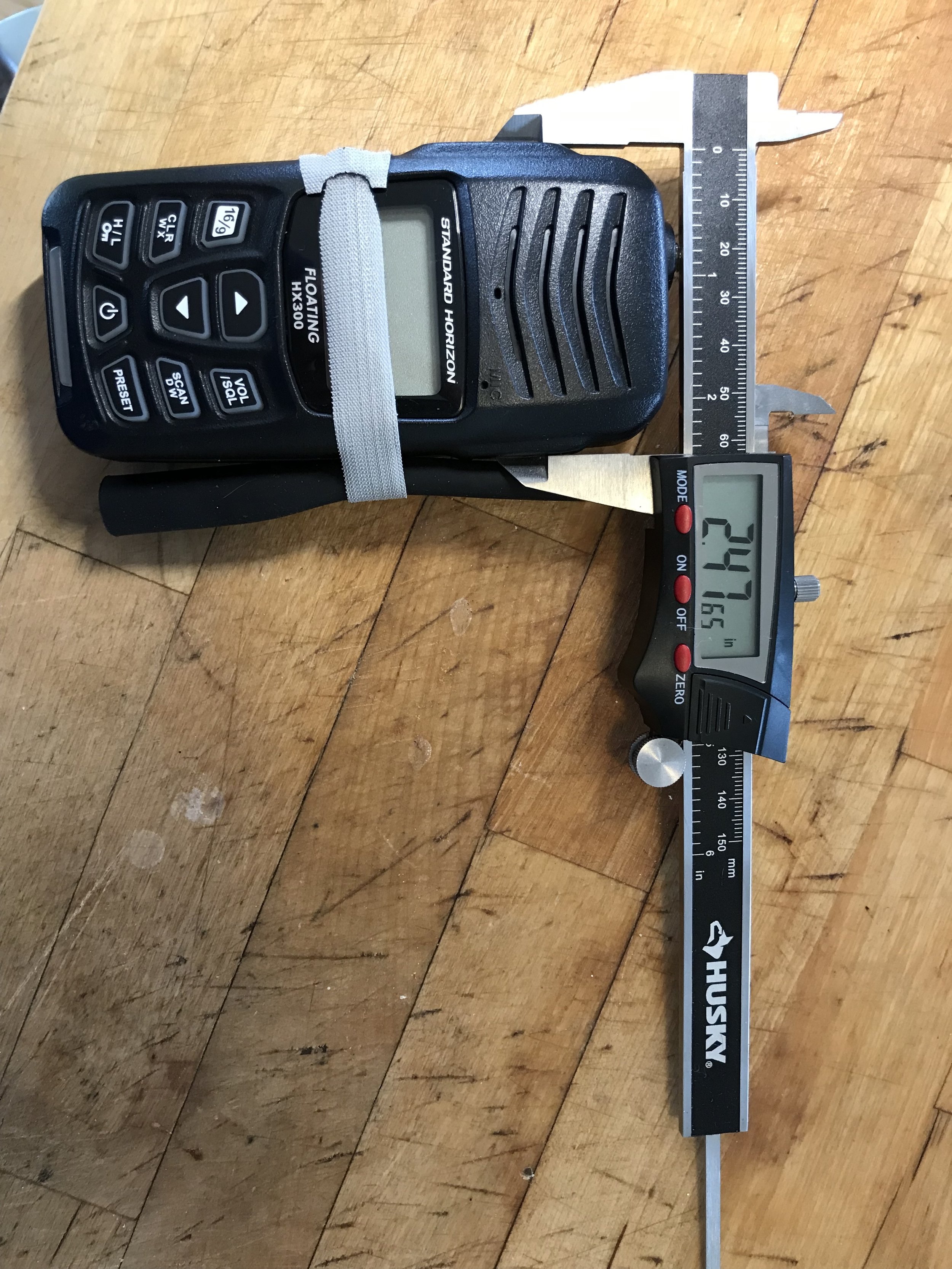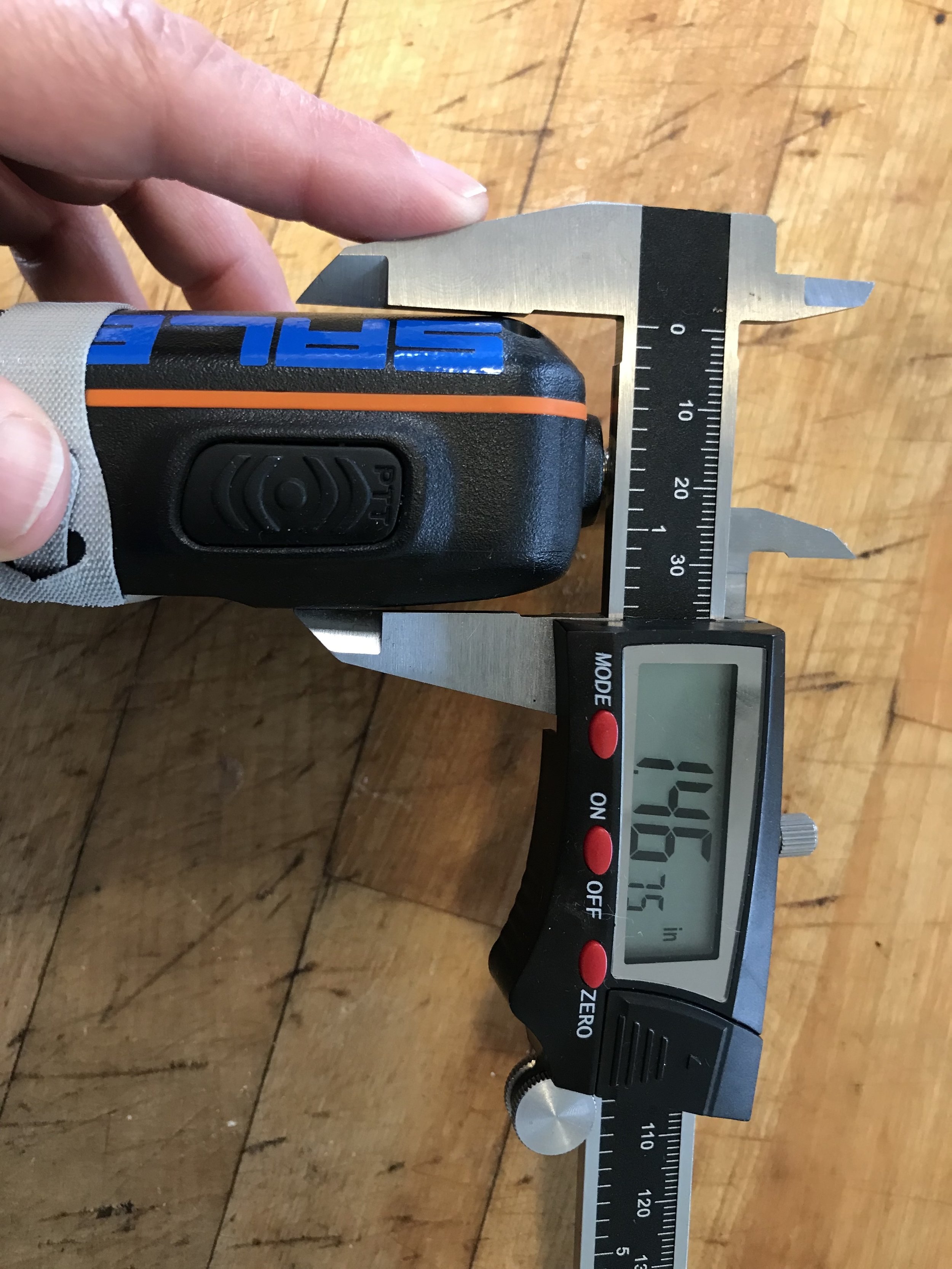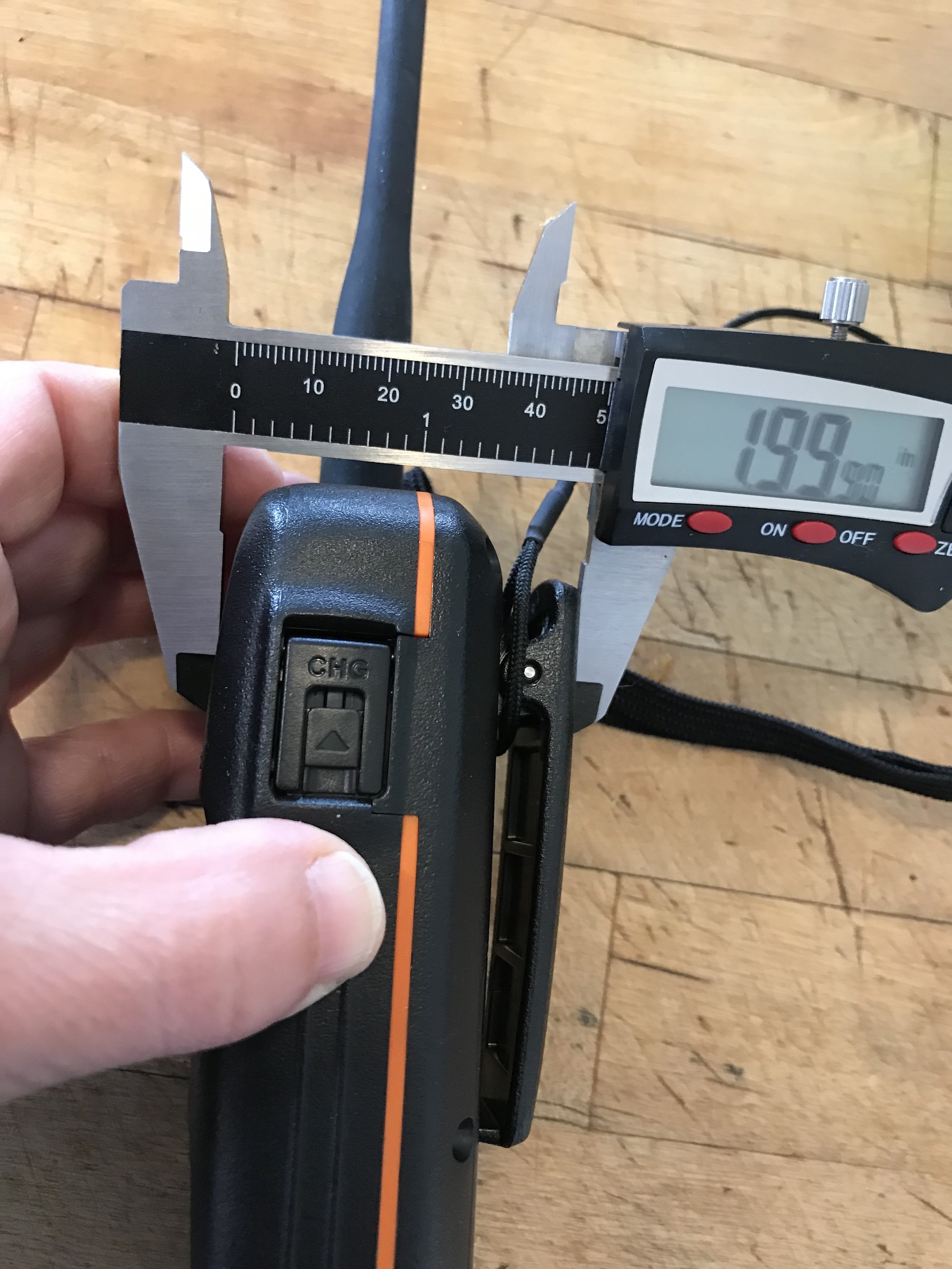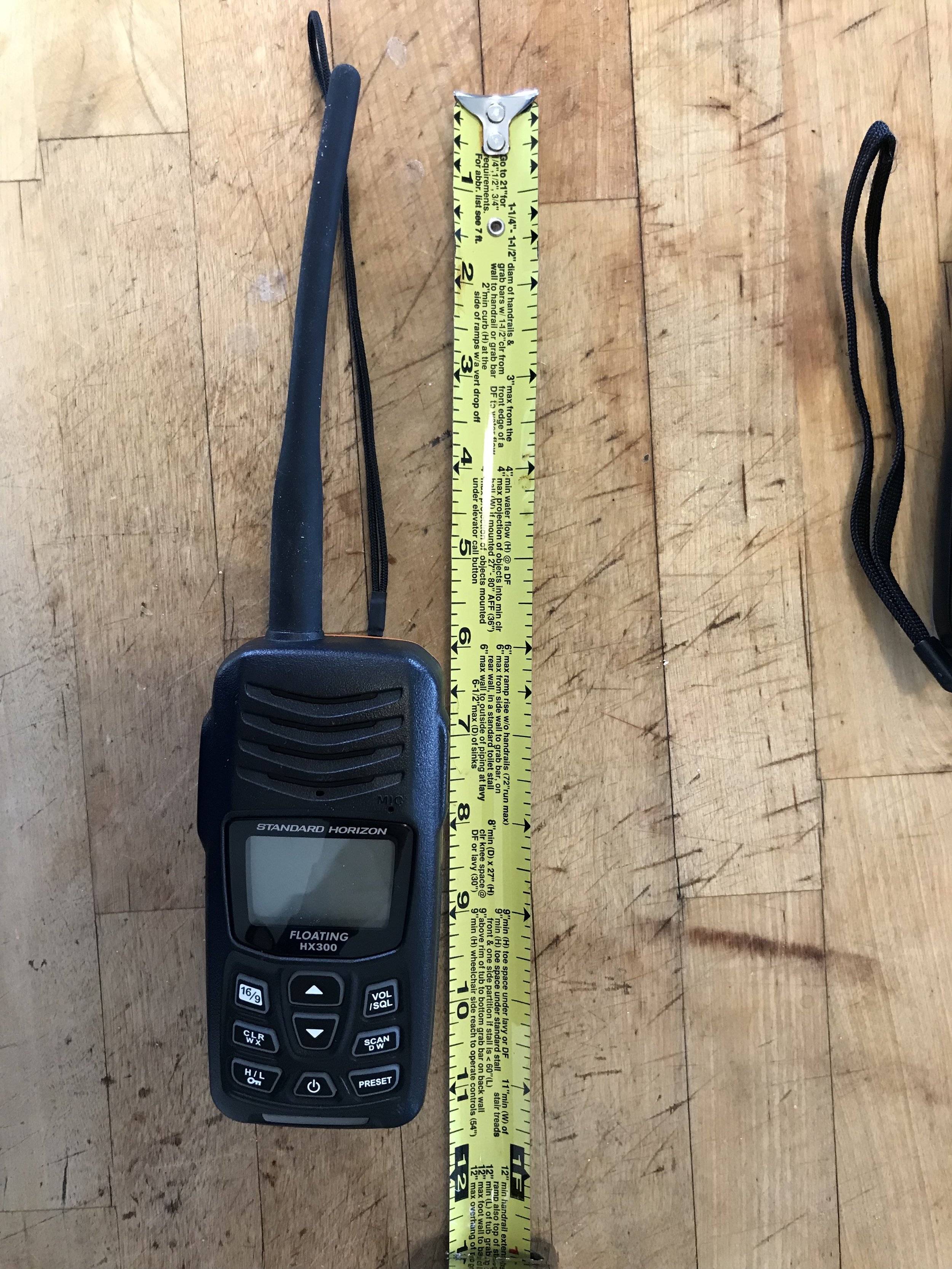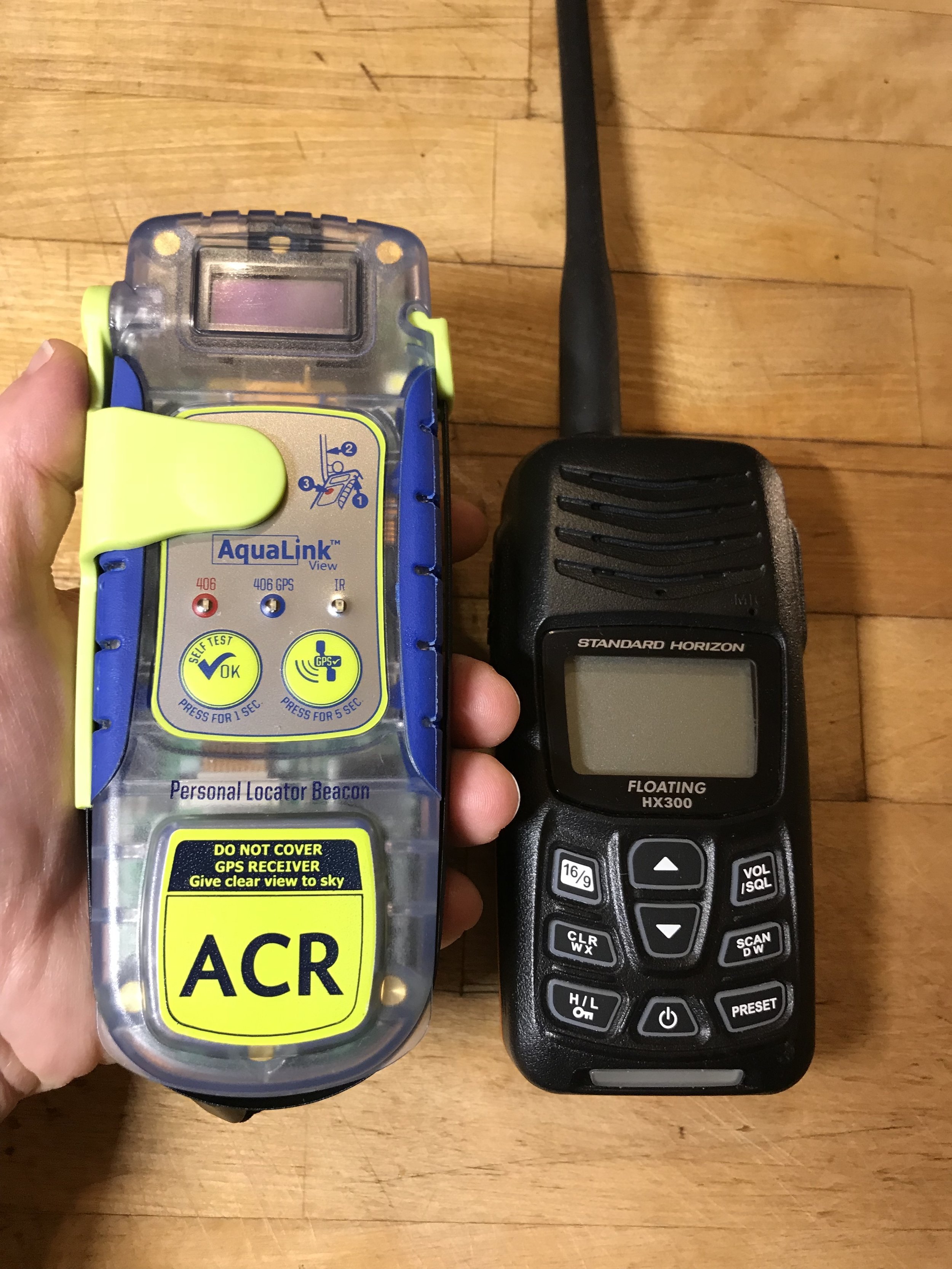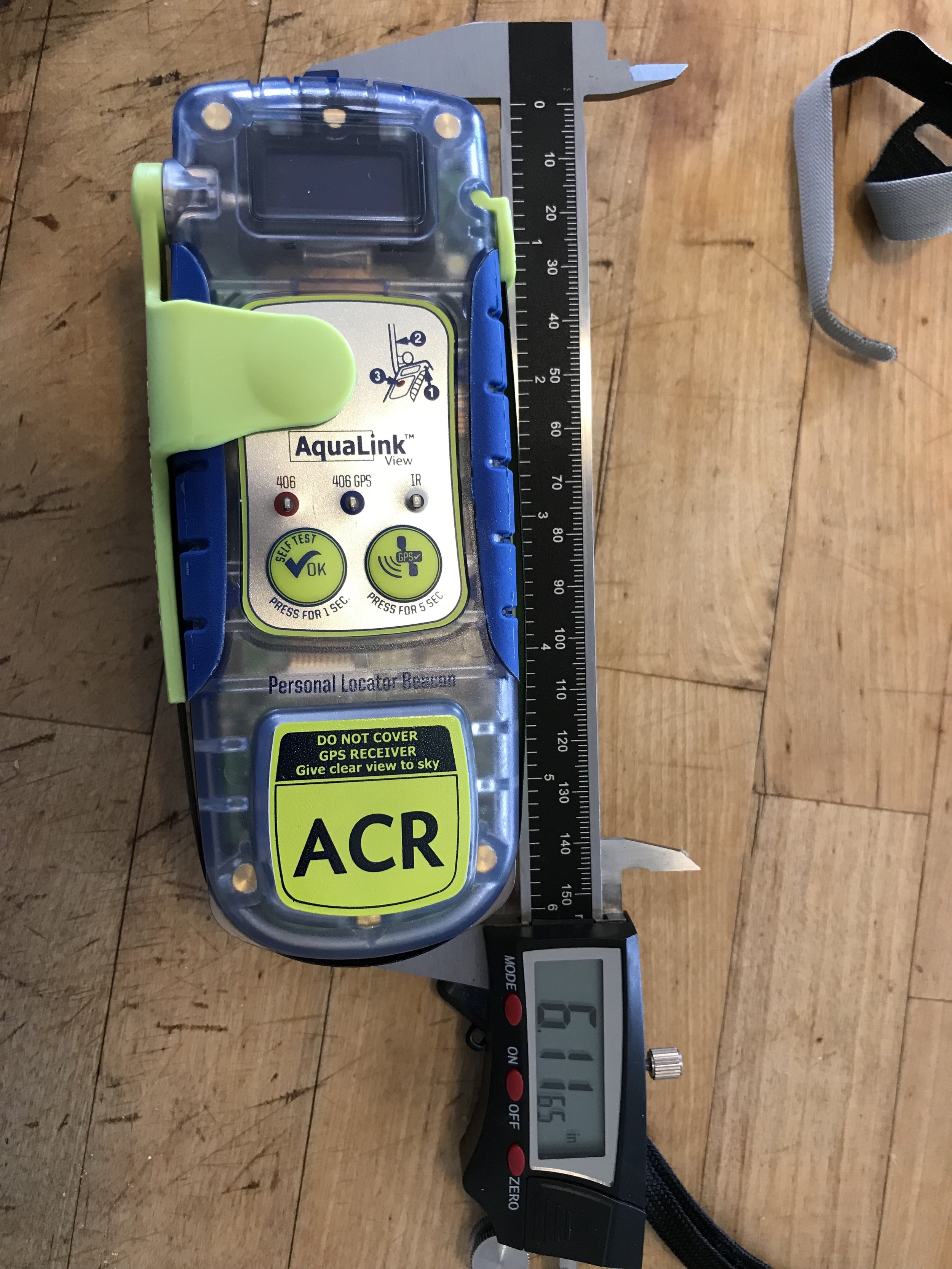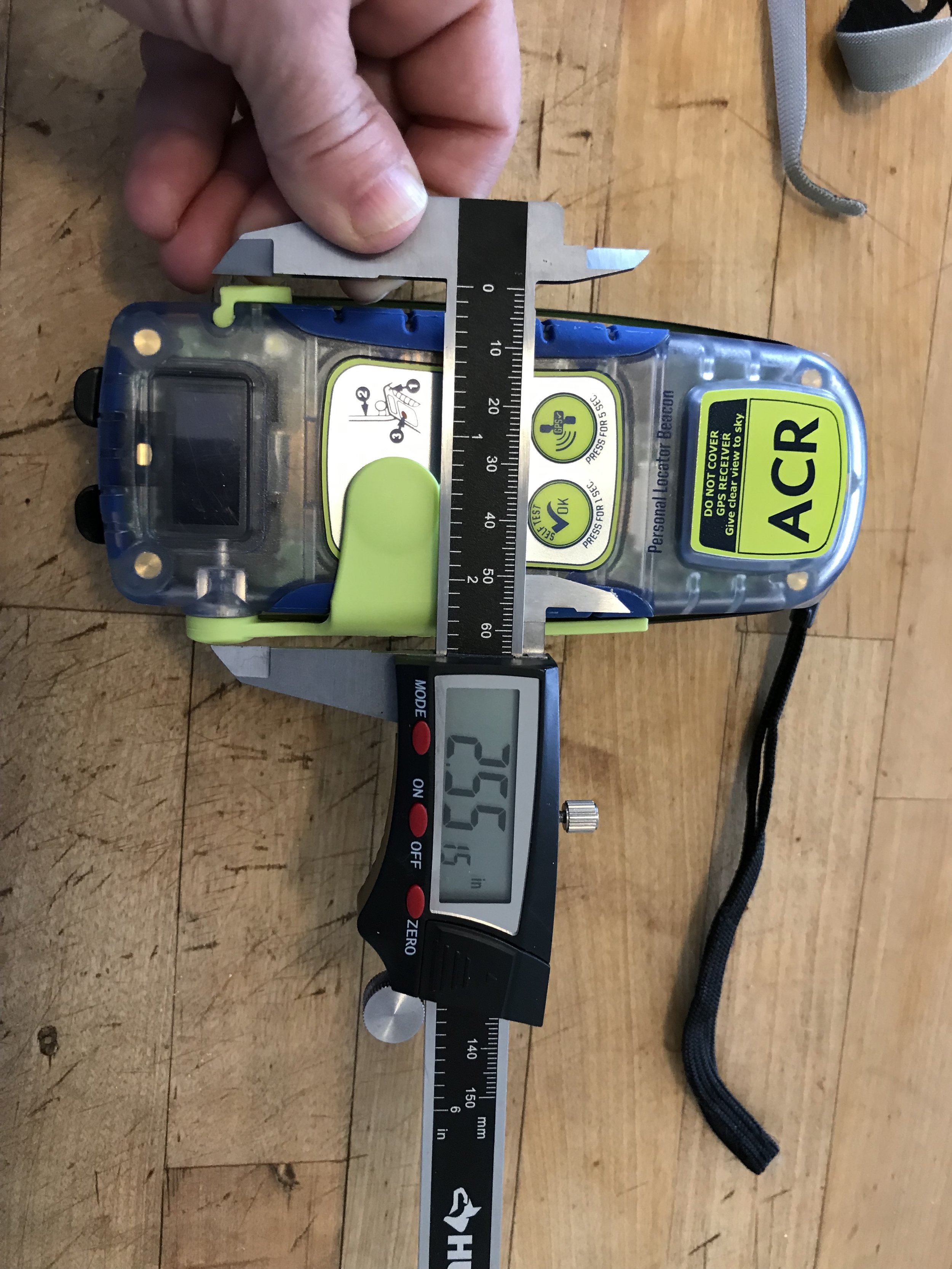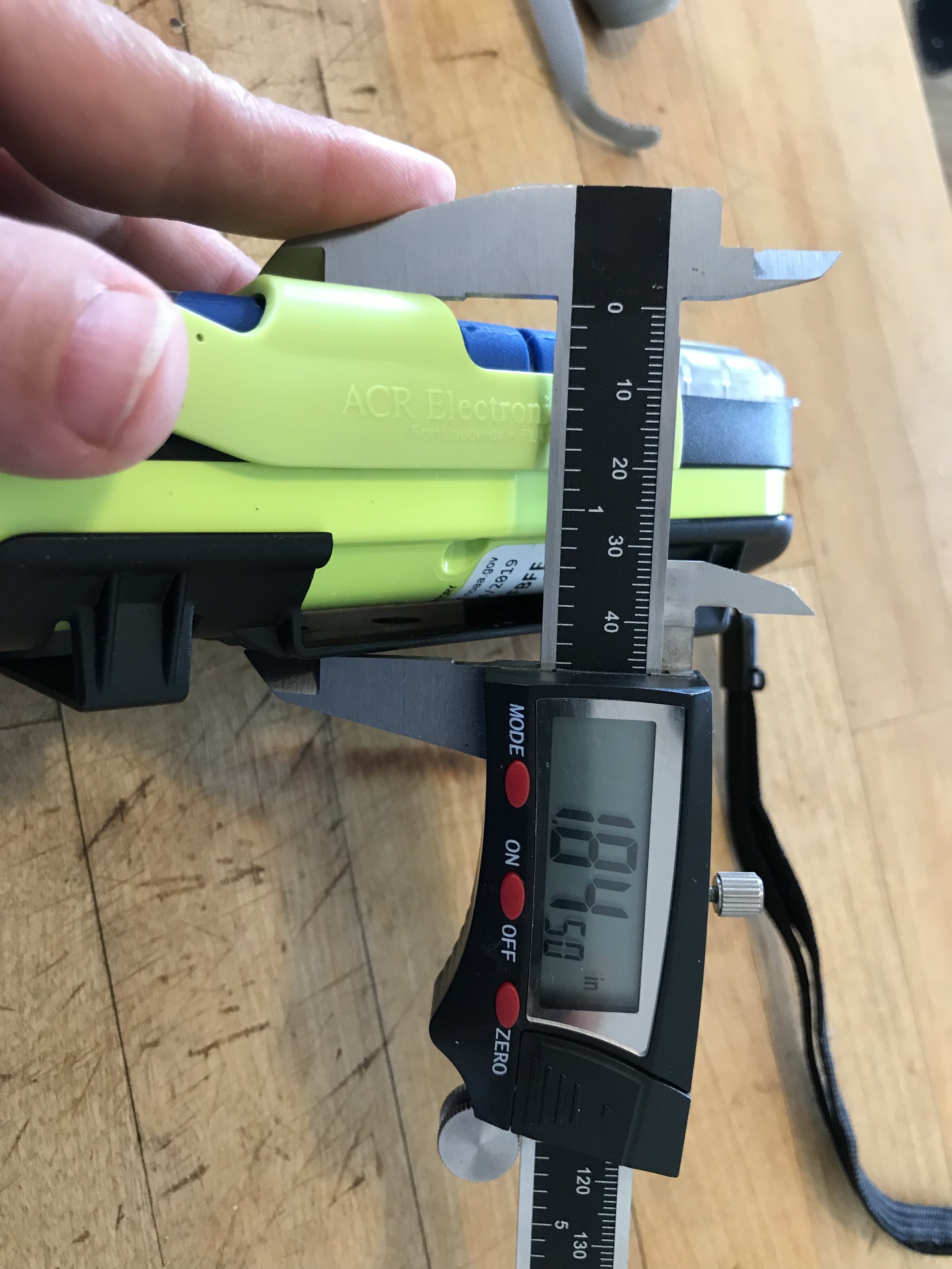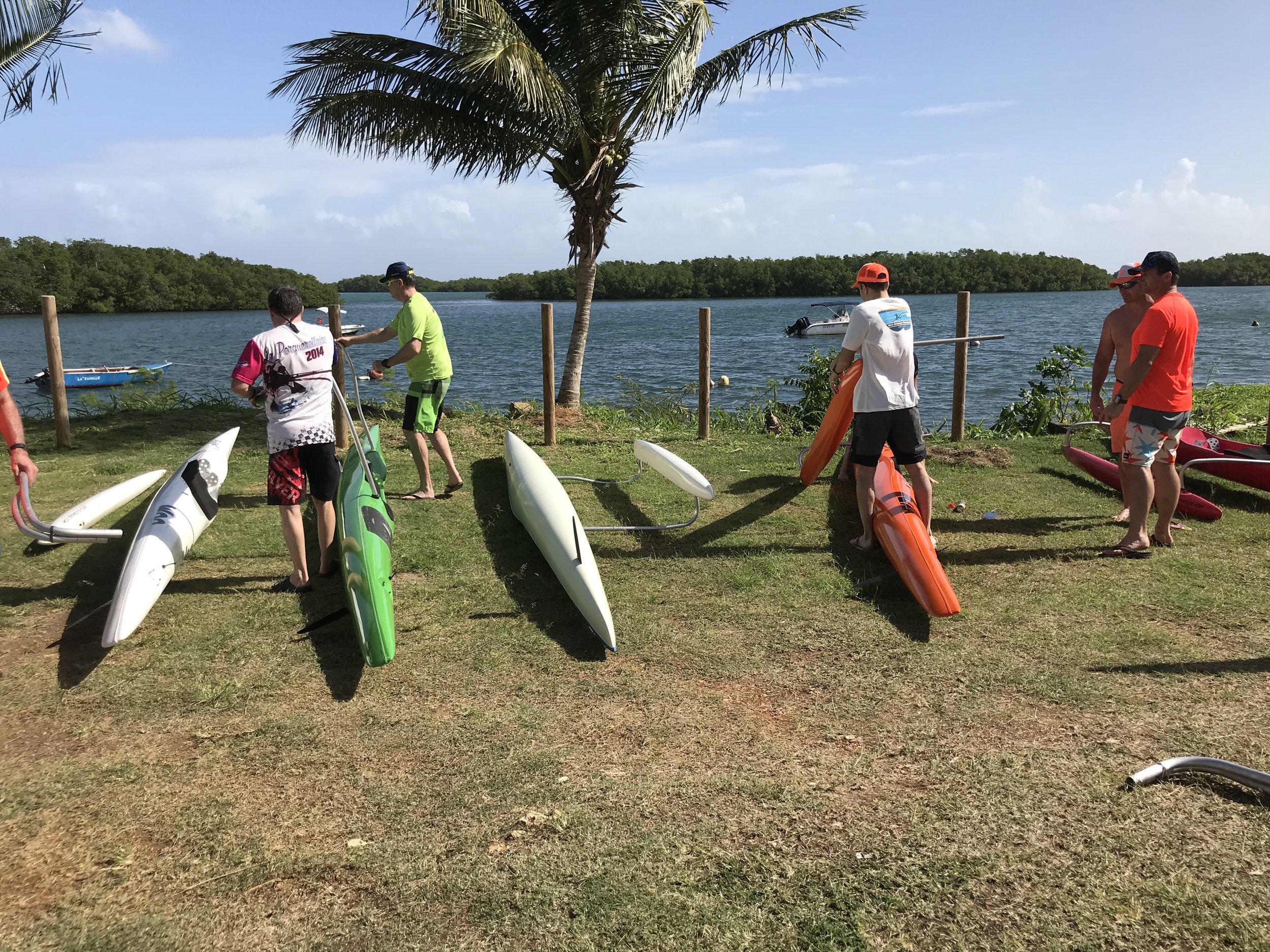UPDATED! November 2019.
Skip the bulky case and attach the HX40 to your PFD or maybe even a floaty, as pictured. You can see it’s barely twice the size of my Apple watch.
In the optional floating orange case, the HX40 is a little bigger than the HX300.
Due to the failure of my HX300, I am updating this entry. I had really liked the USB charging port, but this summer the latch over the port started opening. I got back from a surf session and found the port stuck open, and the light that comes on in the unit when it gets wet was on and blinking. I could not turn it on or off. I removed the battery and tried drying everything in a closed container with Superdry calcium chloride desiccant, but the electronics only partially came back to life. Since I won’t paddle without a radio, I headed to West Marine and bought the new, compact HX40. The HX40 is much smaller due to the fact the built-in flotation of the HX300 has been removed. I bought the optional floating case online, but it proved to be really bulky. Since I connect the radio to my PFD, I think that’s enough flotation for it. The HX40 is pared down. Just turn it on, hit the button for channel 16 and call for “Mayday” if you’re in trouble.
I tested it with my club radios then had it turned on to see if I got any Coast Guard chatter in Long Island Sound. Sure enough, I actually overheard the Coast Guard responding to a vessel in distress. Wow, that was a first time for me. I opened my eyes a little wider just in case I saw anyone in distress, but I did not. The Coast Guard repeatedly called back, without success, for the location of the vessel and number of people on it. I do not know the outcome of this episode, but it really taught me they are there and listening. If you are reading this and in another country, please comment on who patrols your waters and how we reach them by VHF.
While the radio dried and I researched the HX40, I discovered my HX300 had a 3 year warranty. As it was only two years old, off to the manufacturer it went. It was supposed to take 7-10 days for repair, but eventually it just sort of disappeared and no one picked up the phone or answered any more emails. After giving Standard Horizon an email ultimatum, I suddenly got a Fedex tracking number with no other correspondence, and a few days later a brand new HX300 showed up in the mail.
The HX40 is just a better size overall for paddlers, and while I had really liked the USB port, especially for travelling, the HX300 radio is better for boating not for small craft where getting wet and immersion are constant. The belt clip had to be on the HX300 for the strap to attach also. That is not the case for the HX40, which allows you to attach the strap directly to the radio body and then attach this to your PFD without all of the poking bulkiness. The HX40 costs around $100.00. It will be a little annoying to take a wall charger with me while travelling, but to have the electronics fail over the USB latch during some intense surf (hurricane was approaching) was exactly when I didn’t want my gear to fail.
In closing to this update, ACR also has a very compact PLB now that runs about $360.00. While I would like to have a little more room in my PFD, I will hold off on that expenditure for now. Be safe everyone!
HX40 does not float unless you buy the bulky, optional case.
The ACR Aqualink PLB-350C adjacent the Standard Horizon HX300
When I was first invited to paddle OC2 in the New York harbor with an experienced friend, I saw him put on his PFD and put his radio in a pocket. He put his cellphone in a waterproof Pelican box and connected it to the front of the canoe, under the crisscrossing bunjees. He plainly stated that communication must always be carried. I went home that day, in the summer of 2017, and put considerable time into reading reviews of VHF radios. Ultimately I selected the HX300 for its size and features. Over the past year and a half I have frequently paddled with it and have always had it with me on my OC1 in the Hudson River and Long Island Sound.
My review is overdue and prompted from the news of the drowning death of my associate paddler, Alistair Collier of the UK. I spent a week paddling with Ali at the Guadeloupe downwind camp hosted by Woo last year and am utterly disheartened to hear of the paddling community loss of this wonderful gentleman. I have certainly come across the blogs of others covering tragedy, and the focus of this entry is the prevention of any other. Ali’s close friends informed me he did not have any communication device on him and for reasons as yet unknown, the safety boats lost track of him early on during his final race.
I never would have thought a safety escort boat would not be paying attention. We must be prepared for worst case scenarios. I write this entry now not as an idle review but to urge you to be the most responsible person in your canoe.
Your safety is in your hands. The first step you need to take as a paddler is the commitment to safe paddling. When you can save yourself, you have a chance of saving others.
Now for the dry technical stuff.
My biggest concern was size. The bulkier the radio, the bulkier the assembly of stuff on my person, the bulkier my PFD, the harder it is to get onto the canoe. After considerable deliberation I finally chosen the HX 300, which easily fits inside the large front pocket of my Mocke PFD. At 5.25”x2.5”x1.5” this was as compact as I could get with its features.
Standard Horizon HX300 inside the Mocke PFD front pocket. Note the orange whistle also.
Another major consideration was the USB charging port and the orange back light.
The orange light could be indispensable in night conditions.
I have now been using the HX300 for a year and a half. The battery life is great. I actually don’t know how long it lasts before it dies because it has not even gotten close to dying. What little recharge is required takes no time with the USB connection. This is also invaluable for travel outside of the U.S., because of the USB ports-to-other country-voltage chargers prevalent on the phone/computer market.
I recently returned from 2019 downwind paddle camp in Guadeloupe, where channel 71 (canal soixante dix-un) was used by our French coaches for their communication. I tuned in just to have it, just in case. I do not recall seeing any other paddler in the group with a communication device.
For those researching VHF radio use for travels I urge you to make the purchase and ask the locals how it is used in your paddling location. In the U.S., in the New York harbor, we use channel 16 to reach the Coast Guard. Typically I leave the radio on and listen to the intermittent chatter. It is quite reassuring.
If you are thinking your phone will take care of you, keep in mind that you might be in a dead zone for signal, especially in a foreign country or on an island like Guadeloupe. Also keep in mind that you will need to know the local dial code to reach police, etc. A VHF radio could get you in contact with another vessel in close proximity to you right away. “Mayday,” is the universal distress call, which I recently learned is French:
Mayday
universal distress call
If no vessels are close enough to hear your call for distress and survival is questionable, your investment in a personal locator beacon, like the ACR Aqualink PLB-350C is your way to alert the global emergency response teams you are in peril. I purchased the ACR for my trip to Guadeloupe in 2018, and I kept it inside my paddle shorts pocket at all times. I chose the product that is a little bulkier because it incorporates technology that allows you to test that it works periodically. I needed the peace of mind. When I heard about Ali’s untimely fate my first day of camp in 2019, both of my communication devices became my closest allies, ensuring to me that my idea of the greatest time in the world - playing in the ocean - was also respectful of the ocean’s power. We love the ocean, but she has no emotions for us.
Safety has long been an aspect of my dayjob. The general rule is that the day you become so comfortable that you no longer respect your environment, that is the day you are open to getting hurt or worse. When a man at camp told me to do whatever the leader said, because the leader was a safe guy, I respectfully declined and used my own leg leash instead of the one provided. Something as simple as a minor equipment substitution can throw our game. Do what you know is right for you. Rehearse with your safety gear, practice hulis and distress maneuvers with your club. Be your own best guide.
And now for more technical information.
I fumbled with the the ACR antenna when I first got the equipment. The antenna wraps around the body and a male notch on the antenna fits into a female notch on the body of the unit.
The antenna.
When the antenna is up, the red emergency button is exposed. Once pressed a signal is sent to an emergency satellite system, and the dispatch process to search and rescue teams proceeds. Each unit is registered to its individual owner. Mine is registered with NOAA. You must fill out documentation that comes with your unit to get it registered. The search and rescue team will know who you are, where you are and be able to notify next of kin. There are additional packages for texting and so forth depending on what you choose.
The bulk of the unit is the built-in battery, which has a multi-year life expectancy. The only thing it does is send the distress signal and provide your GPS to the search and rescue team.
I’m pretty sure I read something like this when I was reading PFD reviews, but you won’t care what the thing cost when it saves your life. This unit runs about $400. I bought both units online.
Here is a video of what happens when you press the test button:
You won’t be allowed to obsessively test the unit. Doing so would drain the battery. So the computer in the unit will only allow you periodic tests. Don’t abuse it.
The Aqualink comes with a strap and a place to secure it. It also comes with a clip system. The HX300 does not have a strap that works without a clip, which ads to its bulk. I’ve left the clip off and just kept it secure in the PFD pocket.
The straps, clips and belt clips.
In closing, please be an ambassador of the water. Play it safe for yourself and for all others.
Rest in peace, Ali.
LIGHTER: at 4.5 ounces weighs half of other leashes, floats
SMALLER: 50% smaller than other leashes but still extends just as long
STRONGER: heavy duty webbing, stitching and YKK buckle system, 1600lb jacketed Samson Dyneema retractable leash, stainless steel clasp system (no hidden mystery hardware or plasticware like other leashes). Can be used with included Dyneema loops, without hardware, for greatest strength.
SAFER: easy to inspect, high contrast (red, orange, hot pink, lime, yellow or black cuff), red, yellow, orange or pink leash, dual quick release/connect for either race start or getting out of tricky situations
SIZING FOR OUTRIGGER, SUP, SURFSKI, FOIL, PRONE: Retractable leash comes in 9’ or 6’ length. Hardware comes in different sizes for conditions or hands.
SIZING FOR FIT ABOVE CALF: Leash cuff is to be worn above the calf or connected to waist strap.


